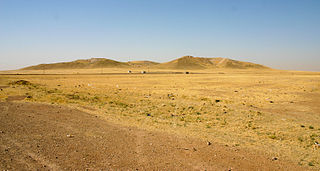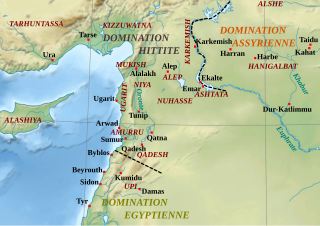Related Research Articles

Ebla was one of the earliest kingdoms in Syria. Its remains constitute a tell located about 55 km (34 mi) southwest of Aleppo near the village of Mardikh. Ebla was an important center throughout the 3rd millennium BC and in the first half of the 2nd millennium BC. Its discovery proved the Levant was a center of ancient, centralized civilization equal to Egypt and Mesopotamia and ruled out the view that the latter two were the only important centers in the Near East during the Early Bronze Age. The first Eblaite kingdom has been described as the first recorded world power.

Kadesh, or Qadesh, was an ancient city of the Levant on or near the headwaters or a ford of the Orontes River. It was of some importance during the Late Bronze Age and is mentioned in the Amarna letters. It was the site of the Battle of Kadesh between the Hittite and Egyptian empires in the 13th century BC.

Qatna was an ancient city located in Homs Governorate, Syria. Its remains constitute a tell situated about 18 km (11 mi) northeast of Homs near the village of al-Mishrifeh. The city was an important center through most of the second millennium BC and in the first half of the first millennium BC. It contained one of the largest royal palaces of Bronze Age Syria and an intact royal tomb that has provided a great amount of archaeological evidence on the funerary habits of that period.

Haddu, was an ancient kingdom in northern Syria, identified with the modern Tell Malhat ed-Deru in Deir ez-Zor Governorate.

Mari was an ancient Semitic city-state in modern-day Syria. Its remains constitute a tell located 11 kilometers north-west of Abu Kamal on the Euphrates river western bank, some 120 kilometers southeast of Deir ez-Zor. It flourished as a trade center and hegemonic state between 2900 BC and 1759 BC. As a purposely-built city, the existence of Mari was related to its position in the middle of the Euphrates trade routes; this position made it an intermediary between Sumer in the south and the Eblaite kingdom and the Levant in the west.
The short chronology is one of the chronologies of the Near Eastern Bronze and Early Iron Age, which fixes the reign of Hammurabi to 1728–1686 BC and the sack of Babylon to 1531 BC.

Eblaite, or Palaeo-Syrian, is an extinct Semitic language which was used during the third millennium BCE by the populations of Northern Syria. It was named after the ancient city of Ebla, in modern western Syria. Variants of the language were also spoken in Mari and Nagar. According to Cyrus H. Gordon, although scribes might have spoken it sometimes, Eblaite was probably not spoken much, being rather a written lingua franca with East and West Semitic features.
Irkab-Damu, was the king (Malikum) of the first Eblaite kingdom, whose era saw Ebla's turning into the dominant power in the Levant.

Tell Brak was an ancient city in Syria; its remains constitute a tell located in the Upper Khabur region, near the modern village of Tell Brak, 50 kilometers north-east of Al-Hasaka city, Al-Hasakah Governorate. The city's original name is unknown. During the second half of the third millennium BC, the city was known as Nagar and later on, Nawar.

The Early Dynastic period is an archaeological culture in Mesopotamia that is generally dated to c. 2900–2350 BC and was preceded by the Uruk and Jemdet Nasr periods. It saw the development of writing and the formation of the first cities and states. The ED itself was characterized by the existence of multiple city-states: small states with a relatively simple structure that developed and solidified over time. This development ultimately led to the unification of much of Mesopotamia under the rule of Sargon, the first monarch of the Akkadian Empire. Despite this political fragmentation, the ED city-states shared a relatively homogeneous material culture. Sumerian cities such as Uruk, Ur, Lagash, Umma, and Nippur located in Lower Mesopotamia were very powerful and influential. To the north and west stretched states centered on cities such as Kish, Mari, Nagar, and Ebla.

Nuhašše, also Nuhašša, was a region in northwestern Syria that flourished in the 2nd millennium BC. It was a federacy ruled by different kings who collaborated and probably had a high king. Nuhašše changed hands between different powers in the region such as Egypt, Mitanni and the Hittites. It rebelled against the latter which led Šuppiluliuma I to attack and annex the region.

The National Museum of Aleppo is the largest museum in the city of Aleppo, Syria, and was founded in 1931. It is located in the heart of the northern city on Baron Street, adjacent to the famous Baron Hotel and near the Bab al-Faraj Clock Tower. The majority of the museum's exhibitions are devoted to the archaeology of Syria, with most of the finds coming from archaeological sites of the northern part of the country.
Armi, was an important Bronze Age city-kingdom during the late third millennium BC located in northern Syria.

Tell Touqan is a village in northwestern Syria, administratively part of the Idlib Governorate, located about 45 kilometers southwest of Aleppo. Nearby localities include Tell Sultan and Tell Kalbah to the east, Abu al-Thuhur to the southeast, Shaykh Idris to the southwest, Kafr Amim to the west, Saraqib to the northwest and Jazraya to the north. According to the Syria Central Bureau of Statistics (CBS), Tell Touqan had a population of 3,531 in the 2004 census.
Hassum was a Hurrian city-state, located in southern Turkey most probably on the Euphrates river north of Carchemish.
Iblul-Il, was the most energetic king (Lugal) of the second Mariote kingdom, noted for his extensive campaigns in the middle Euphrates valley against the Eblaites, and in the upper Tigris region against various opponents, which asserted the Mariote supremacy in the Syrian north.
Kun-Damu was a king (Malikum) of the first Eblaite kingdom ruling c. 2400 BC. The king's name is translated as "Arise, O Damu". Kun-Damu is attested in the archives of Ebla dated two generations after his reign. According to Alfonso Archi, he was a contemporary of Saʿumu of Mari. The archives of Ebla records the defeat of Mari in the 25th century BC, and based on the estimations for his reign, Kun-Damu might be the Eblaite king who inflicted this defeat upon Mari. Aleppo might have came under the rule of Ebla during his reign. Following his death, he was deified and his cult was attested in Ebla for at least 30 years after his reign.
Isar-Damu, was the king (Malikum) of the first Eblaite kingdom. Isar-Damu fought a long war with Mari which ended in Eblaite victory; he was probably the last king of the first kingdom.
Sagisu was a king (Malikum) of the first Eblaite kingdom ruling c. 2680 BC. The king's name is translated as "DN has killed".
Išḫi-Addu or Ishi-Addu was king of Qatna in the first half of the 18th century BC. He is known for his correspondences with Shamshi-Adad I of Assyria who was his closest ally. Qatna was at its height during Išḫi-Addu's reign, which was, however, plagued with revolts in the southern parts of the kingdom and with constant war with Yamhad, Qatna's northern neighbour.
References
Citations
- 1 2 Baffi & Peyronel 2014, p. 13.
- ↑ Castel 2008, p. 307.
- ↑ Morandi Bonacossi 2009, p. 64.
- 1 2 3 Baffi & Peyronel 2014, p. 14.
- ↑ Biga 2010, p. 55.
Sources
- Biga, Maria Giovanna (2010). "War and Peace in the Kingdom of Ebla (24th Century B.C.) in the First Years of Vizier Ibbi-Zikir under the Reign of the Last King Išar-Damu". In Biga, Maria Giovanna; Liverani, Mario (eds.). Ana Turri Gimilli. Studi Dedicati al Padre Werner R. Mayer, S.J. da Amici e Allievi. Vicino Oriente. 5. Università di Roma La Sapienza. OCLC 800926141.
- Baffi, Francesca; Peyronel, Luca (2014). "Tell Tuqan and the Matkh Basin in a Regional Perspective. Thoughts and Questions Raised by the International Conference". In Baffi, Francesca; Fiorentino, Roberto; Peyronel, Luca (eds.). Tell Tuqan Excavations and Regional Perspectives. Cultural Developments in Inner Syria from the Early Bronze Age to the Persian/Hellenistic Period. Proceedings of the International Conference May 15th-17th 2013 - Lecce. Congedo Editore. ISBN 978-8-867-66103-9.
- Castel, Corinne (2008). "Al-Rawda. A town in the Steppe (Central Syria, Early Bronze Age IV)". In Kühne, Hartmut; Czichon, Rainer Maria; Kreppner, Florian Janoscha (eds.). Proceedings of the 4th International Congress of the Archaeology of the Ancient Near East, 29 March - 3 April 2004, Freie Universität Berlin. 2. Otto Harrassowitz Verlag. ISBN 978-3-447-05757-8.
- Morandi Bonacossi, Daniele (2009). Parr, Peter J. (ed.). "Tell Mishrifeh and its Region During The EBA IV and the EBA-MBA Transition. A First Assessment". PEF Annual. The Palestine Exploration Fund. IX: The Levant in Transition. ISBN 978-1-90435-099-6.